Texas Persimmon
(Diospyros texana)
Texas Persimmon (Diospyros texana)
/
/

Annika Lindqvist
CC BY 4.0
Image By:
Annika Lindqvist
Recorded By:
Copyright:
CC BY 4.0
Copyright Notice:
Photo by: Annika Lindqvist | License Type: CC BY 4.0 | License URL: http://creativecommons.org/licenses/by/4.0/ | Rights Holder: Annika Lindqvist | Publisher: iNaturalist | Date Created: 2020-06-25T11:29:11-07:00 |


















































Estimated Native Range
Summary
Diospyros texana, commonly known as Texas Persimmon, is a deciduous or semi-deciduous tree or shrub native to Texas and northeastern Mexico, often found in limestone outcrops, chaparral, and brushland areas. It has a lifespan of 30 to 50 years and typically grows to 3 m (9.8 ft) in height, but can reach 12 m (39 ft) in optimal conditions. The bark is smooth and light reddish-gray, peeling on mature trees to reveal a mottled pattern of pink, white, and gray, which is particularly attractive in the winter landscape. The white, urn-shaped flowers are small, about 0.8–1.6 cm (0.31–0.63 in) wide, and bloom in the spring. Although not particularly showy, they are followed by black, subglobose berries that are edible when ripe and attract wildlife.
Texas Persimmon is valued for its ornamental bark, drought tolerance, and low maintenance requirements, making it suitable for xeriscaping and naturalistic plantings in arid regions. It is used as a specimen plant, for wildlife gardens, and in erosion control. This species thrives in full sun and well-drained, alkaline soils, and once established, it requires minimal watering. While generally disease-free, it can be susceptible to root rot if overwatered. Gardeners should be aware that the female trees will produce fruit, which can be messy if the tree is planted near walkways or patios.CC BY-SA 4.0
Texas Persimmon is valued for its ornamental bark, drought tolerance, and low maintenance requirements, making it suitable for xeriscaping and naturalistic plantings in arid regions. It is used as a specimen plant, for wildlife gardens, and in erosion control. This species thrives in full sun and well-drained, alkaline soils, and once established, it requires minimal watering. While generally disease-free, it can be susceptible to root rot if overwatered. Gardeners should be aware that the female trees will produce fruit, which can be messy if the tree is planted near walkways or patios.CC BY-SA 4.0
Plant Description
- Plant Type: Tree, Shrub
- Height: 20-30 feet
- Width: 20-30 feet
- Growth Rate: Slow
- Flower Color: N/A
- Flowering Season: Spring
- Leaf Retention: Deciduous
Growth Requirements
- Sun: Full Sun, Part Shade
- Water: Low
- Drainage: Medium
Common Uses
Bee Garden, Bird Garden, Butterfly Garden, Deer Resistant, Drought Tolerant, Edible*Disclaimer: Easyscape's listed plant edibility is for informational use. Always verify the safety and proper identification of any plant before consumption., Fragrant, Hedges, Low Maintenance, Street Planting
Natural Habitat
Native to limestone outcrops, chaparral, and brushland areas in Texas and northeastern Mexico
Other Names
Common Names: Mexican Persimmon, Black Persimmon, Chapote
Scientific Names: , Diospyros texana, Brayodendron texanum, Diospyros cuneifolia, Diospyros mexicana,
GBIF Accepted Name: Diospyros texana Scheele